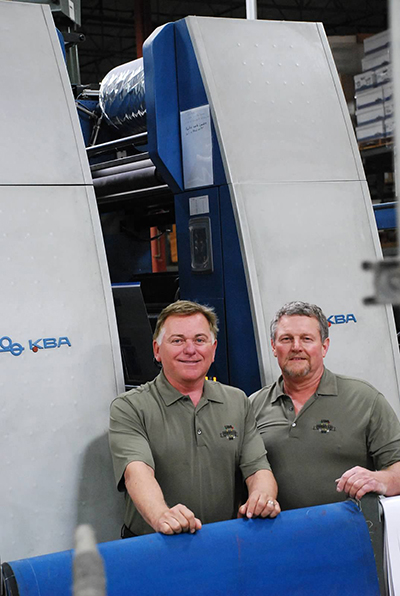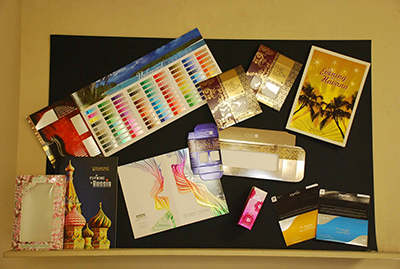Offset Printing | UBS Sees Cold Foil Applications Grow
- Published: April 02, 2013
When UBS Printing Group installed a KBA Rapida 105 41-in. eight-color press with an in-line cold foiling system in 2007, it was the first site with this type of Foiltone system in the US. Since then, this press has become a key workhorse for this southern California high quality packaging firm, producing boxes for the cosmetic, health supplement, and movie industry markets.
“In today’s market, customers are seeking eye-grabbing methods for more economical packaging. They want more bling for less cost. We deliver with this press,” states Gilbert Ashdown, operations manager for UBS Printing Group located in Corona, CA, outside of Los Angeles.

Multi-Colored Foil Effects Using Only Silver Foil
The Foiltone cold foil application process produces multi-colored foil effects using only silver foil. The process lays cold foil onto a printed adhesive and adheres in the printed pattern providing the ability to foil full solids, small reverse-outs, and a range of half tones not possible with conventional hot foil stamping. The cold-foil process uses separate glue, which is still tacky when the foil is pressed on to it, using pressure but no heat. An image is printed in glue on the first unit, using a standard offset plate imaged in a normal way—this is how the process avoids using dies.
After being printed with glue, the sheet passes out of the first unit and into the second. Standing over the second unit is a foil unwind that uses a direct-drive servo to feed foil down into the unit, around the blanket cylinder, and exit it at the back, where it is rewound on to another axle mounted over the unit. But if you need to print large images like posters or banners, you may need to consider getting a large model that has more features and high print speeds.
The overprinting of the foil with four-color process provides designers with new and exciting possibilities restricted only by the imagination. In addition, the solution offers cost reduction on current two or three pass production techniques. Since the system is in-line, there is none of the costs or problems associated with off-line post processing.
“Our KBA Rapida 105 eight-color with cold foiling is our busiest press,” says Ashdown. “By having the capability to produce eight colors in a single pass or a foil job in a single pass with six colors, we have set our company apart from our competition. We’re able to produce litho wraps and packaging from 60-lb label to 18-pt plastic and SBS board. The combination of the automated KBA press plus its cold foiling feature gives us high quality, fast turnaround, less waste, and increased efficiency and environmental benefits.”
Another advantage of its KBA press is the UV coating feature. UBS Printing Group uses UV for both shine and protection on its customers’ packaging. In addition, the firm is able to use UV for different design effects, such as gloss and custom coating.
“Our customers are very demanding of high quality,” says Ashdown. “Our KBA press with in-line cold foiling gives us much finer detail, finer type, and finer lines up to 133 line screens. Our biggest market is the cosmetic industry in which we are charged with matching flesh tones, hair colors, and fingernail polishes on the package. Our second biggest market would be the health supplement/vitamin industry. In the vitamin aisle, our customers are seeking a package that jumps off of the shelf. Since shelf space has been shrinking, manufacturers are reducing the size of their packages but still need to add enough razzle-dazzle to attract the eyes of consumers.”

Ashdown notes that UBS is deriving many environmentally friendly benefits with its KBA press and the cold foil process. Its lower ink usage reduces costs because the firm does not have to throw unused ink away. Its cold foil process provides environmental benefits because the firm uses less energy due to only one pass through the press and no heat is involved. The Foiltone cold foil application process, when compared to traditional hot foiling, has a power requirement to foil a given sheet that is reduced by as much as 75%. This is calculated by measuring a cold foiling operation in which the unit consumes less than half of the power of a similar sized hot foil stamping platen and runs at twice the speed. Jobs are therefore completed in half the time.
Recently, UBS printed a multi-color brochure for its Canon copier account. Ashdown explains that the popular job needed to be reprinted four different times for the customer. Using the cold foil on the press, UBS was able to produce a very vibrant logo. One of its first jobs on the press was a 400,000 piece run of packaging for the Blu-ray DVD edition for the movie industry using cold foil to draw customers to the box.
“Having these capabilities, I can run a large gamut of colors,” says Ashdown. “I can print multiple colors like a ribbon. It provides our design customers with a whole new level of creativity for their packaging. Next week I am printing a job where we’re splitting the ink fountains to provide two different colors giving us nine colors on the package. Each side of the box will be different. Our cold foil system is fitted to the first two units of our KBA Rapida 105, and it allows us to lay the foil down first and then single-pass print over the top of the foil to give us a range of metallic colors.”
Benefits of Cold Foil
Before the KBA Rapida 105 installation with Foiltone cold foiling, UBS Printing Group offered hot foiling capabilities for 10-15 years. “We sell our cold foil applications as something unique to us,” says Ashdown. “What makes cold foil more popular than hot foiling is that logos, solids, and screens do not reproduce onto the other side. For our high-end customers, that is very important.”
Ever since it was founded in 1984, UBS Printing Group has been reinventing itself as it changes with the ever-evolving market. Gene Hamrick, the president and CEO of UBS Printing Group, established the company in Orange County as a printing, packaging and label brokerage. Five years later, the firm began to offer commercial print production including print manuals, company brochures, and direct mail for the nearby computer hardware and software companies. After years of solid growth, customer habits began to change and Hamrick needed to again reinvent his company where he could provide more added-value. The result was an aggressive expansion into packaging printing. Hamrick upgraded the pressroom to include two six-color 41-inch KBA Rapida 105 perfectors equipped with aqueous and UV coaters and then the KBA Rapida 105 eight-color 41-in. press in 2007.
As it looks to its future, Ashdown says the firm will continue to invest in new equipment to remain competitive. A new large format sheetfed press is in the plans as well as the die-cutting equipment associated with a larger size. Coming soon, says Ashdown, will be the ability to print holographic images on packaging, such as toothpaste boxes.
This email address is being protected from spambots. You need JavaScript enabled to view it.




